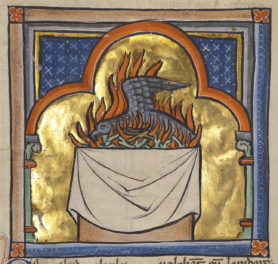Looking for opportunities to exercise your creativity in 2011? Consider Getty Drawing Hour, a free program that offers a chance to draw from the Old Masters, with lessons—and plenty of encouragement—from a professional artist. I tried it out on a recent Sunday, joining a group of 25 novice and experienced artists for two hours of sketching and discussion in the Dutch paintings galleries.

Artist Stas Orlovski leads a discussion of participants\’ portrait sketches at Getty Drawing Hour.
We gathered around painter Stas Orlovski, who set up shop in front of a regal 17th-century portrait bust. Stas had an unexpectedly challenging topic in store for us: the human head.
The first step in drawing the human head is seeing the human head. Stas sketched an oval and asked how far down from the top the eyes should go. Easy question, right? Yet no one really knew.
“A third of the way down?” someone guessed.
“More like half way,” he explained, bisecting the oval on the paper. “People misjudge the position of the eyes based on the hairline. Try imagining the person you’re drawing without hair.”
It was hard to practice this optical trick on the bewigged statue, so Stas pointed to his own crewcut head as an example. Sure enough!
Stas offered more rules of thumb: situate the nose halfway between eyes and chin; fight the tendency to draw ears like Mickey Mouse. Then we fanned out to practice sketching these landmarks in the galleries.
Next we were ready to tackle features. I was amazed by how little I actually knew about the human face. Working step by step from the marble bust, Stas showed us how to break a nose (so to speak) into sculptural components. He molded the nose in graphite, rendering the massive pyramid with dramatic slopes, a flat plane on top, robust nostrils, and a protruding ball that cast a deep shadow. Now this was a nose!
Eyes, too, had a hidden geometry. “Eyes don’t float on the human face,” Stas reminded us. “Try sketching the socket first and then putting the eye inside. Look around the gallery—you’ll see that painters indicate eye sockets with shifts of color, value, and brushstoke.” Feeling suddenly very advanced, on our next practice round I was able to capture some of the depth of eye in a Frans Hals.

Sketch after Frans Hals\’s painting Saint John the Evangelist from 1625–28
I was sitting next to Erin Young, a beginning artist who was patiently sketching the marble bust with The Nose. She’d joined Getty Drawing Hour the previous month and was back for more. “It’s really opened my eyes to seeing the world through art,” she said enthusiastically. “Now I feel like there’s more dimension to the paintings and drawings I see in the museum.” A music student with a BFA in dance, Erin had already studied anatomy and learned to think spatially, though never on paper.
After our final drawing session, Stas gathered the group together so we could discuss our work. We were all impressed by two artists who had gone for the big fish—Rembrandt—and captured his eyes and furrowed brows with remarkable feeling.
The two hours were up already. Stas left us with a thought that wouldn’t have made sense when we first walked in. “Spending 10 minutes in front of a painting, which is what we’ve done here, can actually be shocking. It’s amazing how much you observe.” He invited us to return to the program or drop by the galleries any time with pencil and paper, to be shocked again.
Getty Drawing Hour is offered at the Getty Center on the first and third Sunday of every month (this month, that’s January 2 and 16), and moves outdoors to the Central Garden in summer. Drawing kicks off at 3:30 p.m.; sign-up begins at 2:30 p.m. at the Museum Information Desk. Bring your own lucky pencil or use materials we provide for free.




can i sign up ahead of time as i live many hours away and want to make sure i get in. ? Thank you. It would be cool to come. and I don’t care for lines.
Hi Elizabeth — Getty Drawing Hour is a drop-in program, so it’s first come, first served. The crowd really varies depending on the day; if you come a few minutes before 2:30 p.m., you would only need to wait a short time to get your name on the list. Most people are usually accommodated. Hope to see you next time! –Annelisa
I am 40 years old with some sketching experience (wishing to learn more). I’m excited to participate. My daughter is 10 with promising art skills. Is this course something we can do together? Thanks! -S
Hi Sergei! Absolutely. Although the program is geared to adult participants, if your daughter is interested in learning focused art skills (such as anatomy or portraiture), and two hours is a good length of time, then you would really enjoy it. Another program that might be of interest is the companion program specifically geared for adults and kids to do together, Family Drawing Hour. The next dates for Family Drawing Hour are December 3 and 17, 2011. It’s an hour long (instead of two). Maybe you’d like to try both and see which you prefer. Have a good time!
Hi Sergei! Absolutely. Although the program is geared to adult participants, if your daughter is interested in learning focused art skills (such as anatomy or portraiture), and two hours doesn’t feel like too much to bite off, then you would really enjoy it. Another option that might be really fun is our companion program specifically geared for adults and kids to do together, Family Drawing Hour. The next dates for Family Drawing Hour are December 3 and 17, 2011. It’s one hour long (instead of two). Also, visitors to the Museum are welcome to come sketch on their own using dry media; here are some tips from one of our gallery teachers, William Zaluski, who often leads Family Drawing Hour. Have a great time!